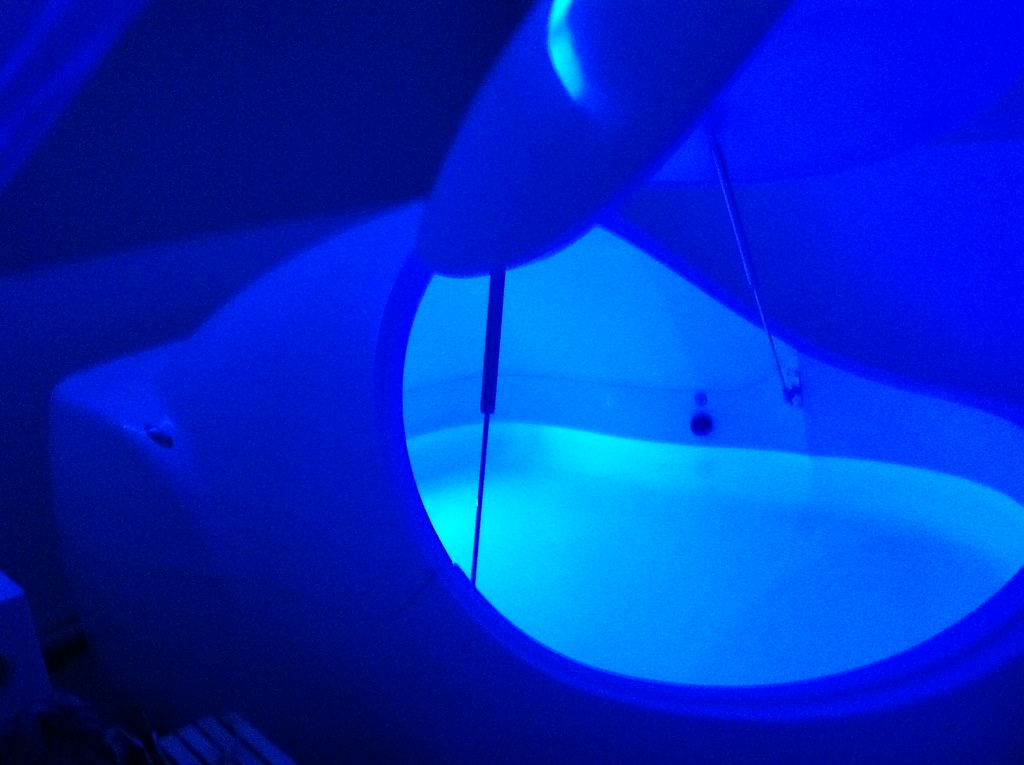Sensory deprivation tanks, also known as float tanks or isolation tanks, have become increasingly popular as a tool for relaxation and stress relief. These tanks are soundproof, lightproof pods filled with saltwater that allows individuals to float effortlessly in a state of near-weightlessness, free from external stimuli. By blocking out sensory input, sensory deprivation tanks are designed to help the mind and body enter a deeply relaxed state, akin to meditation or deep sleep.
In this guide, we’ll explore the science behind sensory deprivation tanks and whether they are effective for relaxation, stress relief, and overall well-being. We’ll look at how they work, the potential benefits, and any considerations to keep in mind when using them.
1. How Sensory Deprivation Tanks Work
Sensory deprivation tanks are filled with a mixture of water and Epsom salt (magnesium sulfate), which allows the body to float effortlessly on the surface of the water. The salt content is so high—about 1,000 pounds of Epsom salt in a standard tank—that the water becomes denser than the body, allowing you to float without any effort. The water is kept at skin temperature (around 93.5°F or 34.5°C), making it feel almost imperceptible against your skin.
The environment inside the tank is designed to eliminate all external stimuli:
- No light: The tanks are completely dark, so there is no visual input.
- No sound: They are soundproof, blocking out external noise.
- No gravity: Floating in the water creates a sensation of near-weightlessness.
- No touch: Because the water and air are kept at skin temperature, you barely feel the water on your skin.
This sensory isolation creates an environment that allows the brain and body to rest in a state of deep relaxation, free from the constant input of sights, sounds, and physical sensations that the brain typically processes.
2. Stress Reduction and Relaxation
One of the most well-documented benefits of sensory deprivation tanks is their ability to reduce stress and induce relaxation. The absence of sensory input allows the nervous system to shift from the sympathetic state (associated with the “fight or flight” response) to the parasympathetic state (associated with rest, relaxation, and recovery).
Several studies have shown that floating in a sensory deprivation tank can reduce levels of cortisol, the primary hormone associated with stress. In a study published in the journal Biological Psychology, participants who floated in sensory deprivation tanks showed significant reductions in cortisol levels, as well as improved mood and decreased feelings of anxiety and stress. This effect is similar to the benefits achieved through meditation or mindfulness practices, but it may occur more quickly due to the complete removal of external stimuli.
The relaxation induced by sensory deprivation tanks can lead to physical benefits as well. By allowing the body to rest deeply, float therapy has been shown to reduce muscle tension, improve sleep quality, and even alleviate symptoms of burnout. For those dealing with chronic stress, floating can offer a break from the mental and physical demands of daily life, providing a calming and restorative experience.
3. Enhanced Mental Clarity and Focus
In addition to its physical relaxation benefits, sensory deprivation tanks can enhance mental clarity and focus. By eliminating distractions and quieting the mind, the brain can enter a theta wave state, which is typically associated with deep relaxation and creativity. This state is often experienced during meditation or just before falling asleep, when the mind is calm but still alert.
For many people, this state of deep relaxation and mental quiet can lead to improved concentration and problem-solving abilities. Some users report having moments of insight or creative breakthroughs while floating, as the mind is free to wander without the usual distractions of daily life. This mental clarity can extend beyond the float session, improving focus and cognitive function in the hours or days following the experience.
In a world where we are constantly bombarded with information and stimuli, the opportunity to disconnect and experience mental stillness can be incredibly valuable. Sensory deprivation tanks offer a unique way to access this state of mental clarity and deep focus, helping to reset the brain and improve overall cognitive function.
4. Pain Relief and Muscle Recovery
Beyond relaxation and mental clarity, sensory deprivation tanks are also commonly used for pain relief and muscle recovery. The buoyancy created by the Epsom salt allows the body to float without putting any pressure on the joints or muscles, which can be particularly beneficial for those suffering from chronic pain conditions like arthritis or fibromyalgia.
Additionally, the magnesium in the Epsom salt can be absorbed through the skin, helping to reduce muscle soreness and inflammation. Magnesium is known for its role in muscle function and recovery, and many athletes use float therapy as part of their recovery routine to speed up healing after intense workouts or injuries.
Studies have shown that sensory deprivation tanks can reduce pain perception by promoting relaxation and lowering stress levels, which in turn decreases the intensity of pain. This makes float therapy a useful tool for individuals dealing with chronic pain, sports injuries, or even conditions like migraines.
5. Improved Sleep Quality
One of the lesser-known benefits of sensory deprivation tanks is their potential to improve sleep quality. Many people struggle with insomnia or poor sleep due to stress, anxiety, or physical discomfort. Floating in a sensory deprivation tank can help promote a state of deep relaxation that carries over into better sleep.
Because float therapy reduces stress and lowers cortisol levels, it helps promote the parasympathetic nervous system, which is responsible for restful and restorative sleep. The complete relaxation of the body and mind during a float session can make it easier to fall asleep and stay asleep, leading to improved overall sleep quality.
For people who suffer from chronic sleep issues, regular float sessions may help reset the body’s natural sleep-wake cycle, improving sleep duration and sleep efficiency. By promoting relaxation and reducing stress, sensory deprivation tanks can create the ideal conditions for restful sleep, making them a valuable tool for those looking to improve their sleep habits.
6. Anxiety and Depression Relief
Sensory deprivation tanks have been shown to have a positive impact on anxiety and depression. By removing the external stimuli that often contribute to feelings of overwhelm, sensory deprivation can help individuals enter a deeply relaxed state that reduces anxiety and improves mood.
A study published in the journal BMC Complementary and Alternative Medicine found that float therapy significantly reduced symptoms of generalized anxiety disorder (GAD). Participants experienced a reduction in anxiety symptoms, improved mood, and an increased sense of well-being after floating sessions. The deep relaxation provided by sensory deprivation tanks helps calm the nervous system and reduces rumination, which is often associated with anxiety and depression.
In addition to anxiety relief, float therapy has been linked to improved mood and feelings of happiness. The experience of weightlessness, combined with the calming environment, allows individuals to release mental tension and experience a sense of peace and emotional balance.
7. Mindfulness and Meditation Enhancement
For individuals who practice mindfulness or meditation, sensory deprivation tanks can serve as an ideal environment for deepening their practice. The absence of external distractions allows the mind to enter a meditative state more easily, making it an excellent tool for both beginners and experienced meditators.
Because the tanks eliminate physical and sensory distractions, they can help individuals achieve a state of mindfulness more quickly than traditional meditation practices. In this state, the mind is able to focus on the present moment without the interference of external stimuli, enhancing the effects of meditation and promoting greater mental clarity.
For experienced meditators, floating in a sensory deprivation tank can deepen their meditation practice by helping them access theta brain waves, which are associated with deep meditation, creativity, and enhanced problem-solving. This can lead to a greater sense of inner peace and a more profound meditation experience.
8. Potential Considerations
While sensory deprivation tanks offer many benefits for relaxation and overall well-being, they may not be suitable for everyone. Some individuals may experience claustrophobia or discomfort in the enclosed space of the tank, which can interfere with their ability to relax. However, most modern float tanks are designed with larger interiors, and some facilities offer tanks with open tops to accommodate those with claustrophobia.
Additionally, while float therapy is generally considered safe, individuals with certain medical conditions, such as low blood pressure, epilepsy, or skin infections, should consult with their doctor before using a sensory deprivation tank. Pregnant women should also consult their healthcare provider before trying float therapy.
Sensory deprivation tanks offer a wide range of benefits for relaxation, stress relief, and mental clarity. By creating an environment free from external stimuli, float therapy allows the mind and body to enter a state of deep relaxation that can reduce cortisol levels, improve sleep quality, and enhance mental focus. In addition to promoting relaxation, sensory deprivation tanks can also provide pain relief, support muscle recovery, and alleviate symptoms of anxiety and depression.
For those looking to disconnect from the constant stimulation of daily life, float therapy offers a unique and effective way to achieve mental stillness and physical rejuvenation. Whether you’re seeking




